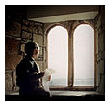
Alpha and Omega are also numbers (2)
Posted by Moderator on Apr 1, 2011 in Mathing | 0 commentsThere’s a famous story about Karl Friedrich Gauss, one of the most distinguished mathematicians of all time. His talent was evident from an early age. His teacher told the class to add up all the numbers from one to 100. Moments later, Gauss appeared at his desk with the correct answer: 5050. The boy later to be known as ‘The Prince of Mathematicians’ had figured out a short-cut. His cunning method of calculation actually works for all similar situations or for so-called ‘triangular’ numbers. Triangular numbers have this name because, if they are arranged in rows of dots on paper, they form perfect triangles. However, they can also be found by adding successive whole numbers together. For instance, 171 is the eighteenth triangular number because all the numbers from one to 18 add to 171 while 153 is the seventeenth triangular number because all the numbers from one to 17 add to 153.
The first three ‘perfect’ numbers are also triangular numbers. 6 is the first perfect number and the third triangular number, 28 is the second perfect number and the seventh triangular number and 496 is the third perfect number and the 31st triangular number. So when John used 496 as the number of syllables in the prologue to his gospel and the number of words in the epilogue, he was using a number that was both perfect and triangular.
It wasn’t a coincidence either. (Neither is the fact that my first paragraph is 153 words and ends on the number 153, or that the first two paragraphs total 231 words.) John used two other triangular numbers in the sub-structure of 496. He used 171 and 325. He also mentioned 153 at the end of his gospel: he reported the number of fish caught in the net when Jesus appeared to his disciples for the third time after His resurrection. When it comes right down to it, even though 496 is perfect and triangular, I really don’t think God inspired John to feature it so prominently for these reasons. I don’t even think John used triangular numbers because he wanted to prove a point to the Pythagoreans Gnostics amongst the Christians who believed numbers were gods—and triangular numbers the highest of all. I think the reason is actually mathematical: there’s a really lovely geometrical theorem that connects 496 to 153. When we multiply 496 by the golden ratio and divide by 2, we get 153. The beautiful thing about that is that the Greeks had a special name for the golden ratio: they called it the logos.
The gospel of John is not just an exquisitely-told eyewitness story of various episodes in the life of Jesus, it is also a mathematical masterpiece as intricately designed as a sunflower or a hummingbird, a galaxy or a cell, a seashell or a fern-frond.
It links the logos as both Word and as corresponding Ratio into the dynamics of the text, a text fearfully and wonderfully made.

